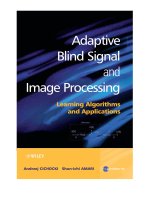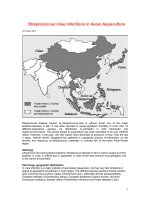Tài liệu 30 Inverse Problems in Array Processing pdf
Bạn đang xem bản rút gọn của tài liệu. Xem và tải ngay bản đầy đủ của tài liệu tại đây (193.63 KB, 19 trang )
Kevin R. Farrell. “Inverse Problems in Array Processing.”
2000 CRC Press LLC. <>.
InverseProblemsinArray
Processing
KevinR.Farrell
T-Netix/SpeakEZ
30.1Introduction
30.2BackgroundTheory
WavePropagation
•
SpatialSampling
•
SpatialFrequency
30.3NarrowbandArrays
Look-DirectionConstraint
•
PilotSignalConstraint
30.4BroadbandArrays
30.5InverseFormulationsforArrayProcessing
NarrowbandArrays
•
BroadbandArrays
•
Row-ActionProjec-
tionMethod
30.6SimulationResults
NarrowbandResults
•
BroadbandResults
30.7Summary
References
30.1 Introduction
Signalreceptionhasnumerousapplicationsincommunications,radar,sonar,andgeoscienceamong
others.However,theadverseeffectsofnoiseintheseapplicationslimittheirutility.Hence,thequest
fornewandimprovednoiseremovaltechniquesisanongoingresearchtopicofgreatimportancein
avastnumberofapplicationsofsignalreception.
Whencertaincharacteristicsofnoiseareknown,theireffectscanbecompensated.Forexample,
ifthenoiseisknowntohavecertainspectralcharacteristics,thenafiniteimpulseresponse(FIR)or
infiniteimpulseresponse(IIR)filtercanbedesignedtosuppressthenoisefrequencies.Similarly,if
thestatisticsofthenoiseareknown,thenaWeinerfiltercanbeusedtoalleviateitseffects.Finally,if
thenoiseisspatiallyseparatedfromthedesiredsignal,thenmultisensorarrayscanbeusedfornoise
suppression.Thislastcaseisdiscussedinthisarticle.
Amultisensorarrayconsistsofasetoftransducers,i.e.,antennas,microphones,hydrophones,
seismometers,geophones,etc.thatarearrangedinapatternwhichcantakeadvantageofthespatial
locationofsignals.Atwo-elementtelevisionantennaprovidesagoodexample.Toimprovesignal
receptionand/ormitigatetheeffectsofanoisesource,theantennapatternismanuallyadjustedto
steeralowgaincomponentoftheantennapatterntowardsthenoisesource.Multisensorarrays
typicallyachievethisadjustmentthroughtheuseofanarrayprocessingalgorithm.Mostapplica-
tionsofmultisensorarraysinvolveafixedpatternoftransducers,suchasalineararray.Antenna
patternadjustmentsaremadebyapplyingweightstotheoutputsofeachtransducer.Ifthenoise
arrivesfromaspecificnon-changingspatiallocation,thentheweightswillbefixed.Otherwise,
c
1999byCRCPressLLC
if the noise arrives from random, changing locations then the weights must be adaptive. So, in a
military communications application where a communications channel is subject to jamming from
random spatial locations, an adaptive array processing algorithm would be the appropriate solution.
Commercial applications of microphone arrays include teleconferencing [6] and hearing aids [9].
There are several methods for obtaining the weight update equations in array processing. Most
of these are derived from statistically based formulations. The resulting optimal weight vector is
then generally expressed in terms of the input autocorrelation matrix. An alternative formulation
is to express the array processing problem as a linear system of equations to which iterative matrix
inversion techniques can be applied. The matrix inverse formulation will be the focus of this article.
The following section provides a background overview of wave propagation, spatial sampling, and
spatial filtering. Next, narrowband and broadband beamforming arrays are described along with the
standard algorithms used for these implementations. The narrowband and broadband algorithms
are then reformulated in terms of an inverse problem and an iterative technique for solving this
system of equations is provided. Finally, several examples are given along with a summary.
30.2 Background Theory
Array processing uses information regarding the spatial locations of signals to aid in interference
suppression and signal enhancement. The spatial locations of signals may be determined by the
wavefronts that are emanated by the signal sources. Some background theory regarding wave propa-
gation and spatial frequency is necessary to fully understand the interference suppression techniques
used within array processing. The following subsections provide this background material.
30.2.1 Wave Propagation
An adaptive array consists of a number of sensors typically configured in a linear pattern that utilizes
the spatial characteristics of signals to improve the reception of a desired signal and/or cancellation
of undesired signals. The analysis used in this chapter assumes that a linear array is being used, which
corresponds to the sensors being configured along a line. Signals may be spatially characterized
by their angle of arrival with respect to the array. The angle of arrival of a signal is defined as the
angle between the propagation path of the signal and the perpendicular of the array. Consider the
wavefront emanating from a point source as is illustrated in Fig. 30.1. Here, the angle of arrival is
shown as θ.
Note in Fig. 30.1 that wavefronts emanating from a point source may be characterized by plane
waves (i.e., the locus of constant phase form straight lines) when originating from the far field or
Fraunhofer, region. The farfield approximation isvalid forsignals thatsatisfy thefollowing condition:
s ≥
D
2
λ
(30.1)
where s is the distance between the signal and the array, λ is the wavelength of the signal, and D is the
lengthof thearray. Wavefronts thatoriginate closerthan D
2
/λare consideredto befromthe nearfield
or Fresnel, region. Wavefronts originating from the near field exhibit a convex shape when striking
the array sensors. These wavefronts do not create linear phase shifts between consequetive sensors.
However, the curvature of the wavefront allows algorithms to determine point source location in
addition to direction of arrival [1]. The remainder of this article assumes that all wavefronts arrive
from the far field region.
c
1999 by CRC Press LLC
FIGURE 30.1: Propagating wavefront.
30.2.2 Spatial Sampling
In Fig. 30.1 it can be seen that the signal waveform experiences a time delay between crossing each
sensor, assuming that it doesnot arrive perpendicular to the array. The time delay, τ, of the waveform
striking the first and then second sensors in Fig. 30.1 may be calculated as
τ =
d
c
sin θ
(30.2)
where d is the sensor spacing, c is the speed of propagation of the given waveform for a particular
medium (i.e., 3 × 10
8
m/s for electromagnetic waves through air, 1.5 × 10
3
m/s for sound waves
through water, etc.), and θ is the angle of arrival of the wavefront. This time delay corresponds to a
shift in phase of the signal as observed by each sensor. The phase shift, φ, or electrical angle observed
at each sensor due to the angle of arrival of the wavefront may be found as
φ =
2πd
λ
o
sin θ =
ω
o
d
c
sin θ.
(30.3)
Here, λ
o
is the wavelength of the signal at frequency f
o
as defined by
λ
o
=
c
f
o
.
(30.4)
Hence, a signal x(k) that crosses the sensor array and exhibits a phase shift φ between uniformly
spaced, consequetive sensors can be characterized by the vector x(k), where:
x(k) = x(k)
1
e
−jφ
e
−2jφ
.
.
.
e
−j(K−1)φ
.
(30.5)
Uniform sensor spacing is assumed throughout the remainder of this article.
c
1999 by CRC Press LLC
30.2.3 Spatial Frequency
The angle of arrival of a wavefront defines a quantity known as the spatial frequency. Adaptive
arrays use information regarding the spatial frequency to suppress undesired signals that originate
from different locations than that of the target signal. The spatial frequency is determined from the
periodicity that is observed across an array of sensors due to the phase shift of a signal arriving at
some angle of arrival.
Signals that arrive perpendicular to the array (known as boresight) create identical waveforms at
each sensor. The spatial frequency of such signals is zero. Signals that do not arrive perpendicular to
the array will not create waveforms that are identical at each sensor assuming that there is no spatial
aliasing due to insufficiently spaced sensors. In general, as the angle increases, so does the spatial
frequency. It can alsobe deduced thatretaining signals having anangle of arrival equal to zero degrees
while suppressingsignals fromother directionsis equivalentto lowpass filtering the spatialfrequency.
This provides the motivation for conventional or fixed-weight beamforming techniques. Here, the
sensor values can be computed via a windowing technique, such as a rectangular, Hamming, etc.
to yield a fixed suppression of non-boresight signals. However, adaptive techniques can locate the
specific spatial frequency of an interfering signal and position a null in that exact location to achieve
greater suppression.
There are two types of beamforming, namely conventional, or “fixed weight”, beamforming and
adaptive beamforming. A conventional beamformer can be designed using windowing and FIR filter
theory. They utilize fixed weights and are appropriate in applications where the spatial locations of
noise sources are known and are not changing. Adaptive beamformers make no such assumptions
regarding the locations of the signal sources. The weights are adapted to accommodate the changing
signal environment.
Arrays that have a visible region of −90
◦
to +90
◦
(i.e., the azimuth range for signal reception)
require that the sensor spacing satisfy the relation
d ≤
λ
2
.
(30.6)
The above relation for sensor spacing is analogous to the Nyquist sampling rate for frequency domain
analysis. Forexample, consider a signalthat exhibitsexactlyoneperiod betweenconsequetivesensors.
In this case, the output of each sensor would be equivalent, giving the false impression that the signal
arrives normal to the array. In terms of the antenna pattern, insufficient sensor spacing results in
grating lobes. Grating lobes are lobes other than the main lobe that appear in the visible region and
can amplify undesired directional signals.
The spatial frequency characteristics of signals enable numerous enhancement opportunities via
array processing algorithms. Array processing algorithms are typically realized through the imple-
mentation of narrowband or broadband arrays. These two arrays are discussed in the following
sections.
30.3 Narrowband Arrays
Narrowband adaptive arrays are used in applications where signals can be characterized by a single
frequency and thus occupy a relatively narrow bandwidth. A signal whose envelope does not change
during the time their wavefront is incident on the transducers is considered to be narrowband. A
narrowband adaptive array consists of an array of sensors followed by a set of adjustable gains, or
weights. The outputs oftheweighted sensorsaresummedtoproducethearray output. Anarrowband
array is shown in Fig. 30.2.
The input vector x(k) consists of the sum of the desired signal s(k) and noise n(k) vectors and is
c
1999 by CRC Press LLC
FIGURE 30.2: Narrowband array.
defined as
x(k) = s(k) + n(k)
(30.7)
where k denotes the time instant of the input vector. The noise vector n(k) will generally consist of
thermal noise and directional interference. At each time instant, the input vector is multiplied with
the weight vector to obtain the array output, which is given as
y(k) = x
T
(k)w, x, w ∈ C
K
,
(30.8)
where C
K
is the complex space of dimension K. The array output is then passed to the signal
processor which uses the previous value of the output and current values of the inputs to determine
the adjustment to make to the weights. The weights are then adjusted and multiplied with the new
input vector to obtain the next output. The output feedback loop allows the weights to be adjusted
adaptively, thus accommodating nonstationary environments.
In Eq. (30.8), it is desired to find a weight vector that will allow the output y to approximately
equal the true target signal. For the derivation of the weight update equations, it is necessary to know
what a priori information is being assumed. One form of a priori information could be the spatial
location of the target signal, also known as the “look-direction”. For example, many array processing
algorithms assume that the target signal arrives normal to the array, or else a steering vector is used
to make it appear as such. Another form of a priori information is to use a signal at the receiving end
that is correlated with the input signal, i.e., a pilot signal. Each of these criteria will be considered in
the following subsections.
30.3.1 Look-Direction Constraint
One of the first narrowband array algorithms was proposed by Applebaum [2]. This algorithm is
known as the sidelobe canceler and assumes that the direction of the target signal is known. The
algorithm does not attempt to maximize the signal gain, but instead adjusts the sidelobes so that
interfering signals coincide with the nulls of the antenna pattern. This concept is illustrated in
Fig. 30.3.
Applebaum derived the weight update equation via maximization of the signal to interference plus
thermal noise ratio (SINR). As derived in [2], this optimization results in the optimal weight vector
as given by Eq. (30.9):
w
opt
= µR
−1
xx
t .
(30.9)
c
1999 by CRC Press LLC
FIGURE 30.3: Sidelobe canceling.
In Eq. (30.9), R
xx
is the covariance matrix of the input, µ is a constant related to the signal gain,
and t is a steering vector that corresponds to the angle of arrival of the desired signal. This steering
vector is equivalent to the phase shift vector of Eq. (30.5). Note that if the angle of arrival of the
desired signal is zero, then the t vector will simply contain ones.
A discretized implementation of the Applebaum algorithm appears as follows:
w
(j+1)
= w
(j)
+ α
w
q
− w
(j)
− βx(k)y(k) .
(30.10)
In Eq. (30.10), w
q
represents the quiescent weight vector (i.e., when no interference is present), the
superscript j refers to the iteration, α is a gain parameter for the steering vector, and β is a gain
parameter controlling the adaptation rate and variance about the steady state solution.
30.3.2 Pilot Signal Constraint
Another form of a priori information is to use a pilot signal that is correlated with the target signal.
Thisresultsina beamforming algorithmthat will concentrateonmaintaining abeamdirectedtowards
the target signal, as opposed to, or in addition to, positioning the nulls as in the case of the sidelobe
canceler. One suchadaptive beamformingalgorithm wasproposedby Widrow [20,21]. The resulting
weight update equation is based on minimizing the quantity (y(k) − p(k))
2
where p(k) is the pilot
signal. The resulting weight update equation is
w
(j+1)
= w
(j)
+ µ(k)x(k) .
(30.11)
This corresponds to the least means square (LMS) algorithm, where is the current error, namely
(y(k) − p(k)), and µ is a scaling factor.
30.4 Broadband Arrays
Narrowband arrays rely on the assumption that wavefronts normal to the array will create identical
waveforms at each sensor and wavefronts arriving at angles not normal to the array will create a
linear phase shift at each sensor. Signals that occupy a large bandwidth and do not arrive normal to
the array violate this assumption since the phase shift is a function of f
o
and varying frequency will
cause a varying phase shift. Broadband signals that arrive normal to the array will not be subject to
frequency dependent phase shifts at each sensor as will broadband signals that do not arrive normal
to the array. This is attributed to the coherent summation of the target signal at each sensor where
the phase shift will be a uniform random variable with zero mean. A modified array structure,
c
1999 by CRC Press LLC









